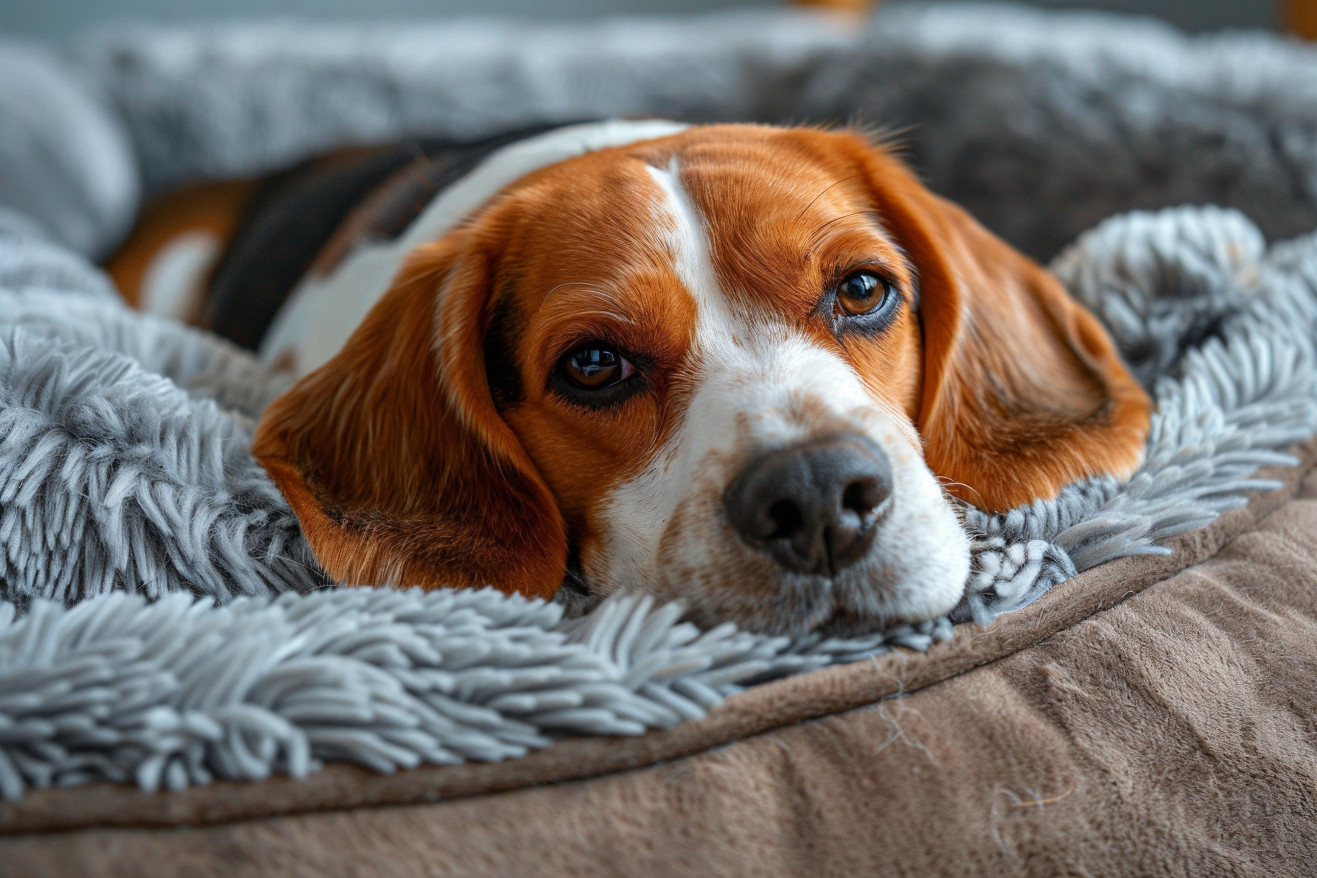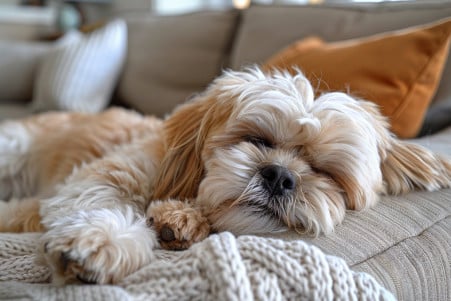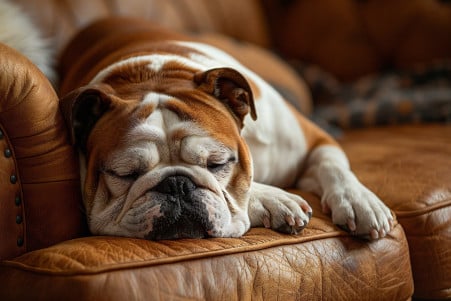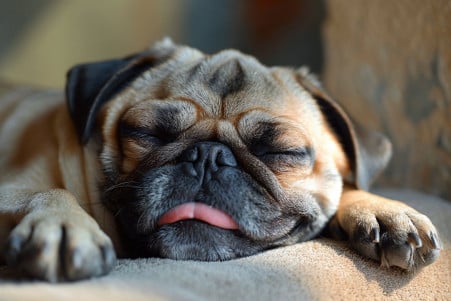Why Do Dogs Sleep with Their Eyes Open? The Science Behind Canine Sleep
23 February 2024 • Updated 22 February 2024

It’s definitely a strange thing to see, but can dogs really sleep with their eyes open? Yes, dogs can sleep with their eyes partially open, and it’s often because their third eyelid is showing.
That said, this is usually a sign of light sleep or dreaming. If a dog sleeps with its eyes open regularly, however, it may be a sign of a health problem that needs to be addressed by a vet.
In this in-depth article, we’ll take a deep dive into the research and clinical literature in veterinary medicine, animal behavior science, and canine neurology to shed light on how dogs sleep. By understanding the unique physical characteristics of dogs, including the third eyelid, and the nuances of their sleep architecture, we can better understand why dogs sleep with their eyes open.
Our goal is to help you better understand and support your dog’s health and happiness by demystifying this phenomenon.
Why do dogs sleep with their eyes open?
Canine Sleep Cycles: Puppies vs. Adult Dogs
Like humans, dogs go through sleep cycles that include deep sleep and the more active Rapid Eye Movement (REM) sleep. During REM sleep, dogs may show signs of dreaming, like twitching, moving their legs, or even sleeping with their eyes open.
A study published in PMC found that puppies’ sleep patterns change as they mature into adults. Puppies at 16 weeks old were shown to sleep more during the day and have a longer total sleep time over a 24-hour period than 12-month-old dogs.
The study also found that older dogs sleep more at night and are more settled when they’re alone. This shift in sleep patterns is important for learning, memory, and the immune system. The details of these patterns are influenced by a dog’s age, breed, personality, and overall health and environment.
These results demonstrate the complexity and individuality of dog sleep and show that more research is needed to understand how sleep impacts a dog’s quality of life. When we think about the third eyelid’s purpose in our dogs’ lives, it’s clear that their sleep is just as important to their well-being as the eye’s role in protecting their vision.
The Nictitating Membrane: The Eye’s Silent Protector
The third eyelid, also known as the nictitating membrane, is located between the cornea and the lower eyelid.
According to Veterinary Key, the nictitating membrane is a protective structure that acts as a membrane and a gland, and it plays a major role in the formation of the tear film that keeps the eye moist.
The nictitating membrane is not just a passive part of the eye, the structures within it, including a cartilage and gland that are shaped like the letter T, are important in maintaining the health of the eye by spreading the tear film and protecting the eye from injury.
One of the most common issues that affect the nictitating membrane is “cherry eye,” which occurs when the gland of the third eyelid pops out, and if left untreated, can lead to dry eye, according to Animal Eye Care. While the size and pigmentation of the third eyelid can differ between breeds, the nictitating membrane’s role in the eye is the same for all dogs.
When your dog is sleeping with its eyes open, the nictitating membrane is still working to protect and moisten the eye. According to South Texas Veterinary Ophthalmology, it’s important to make sure the nictitating membrane is healthy to prevent problems that can lead to vision loss.
The fact that the nictitating membrane is still at work during sleep shows that the body is always working to protect and maintain the health of the eye, even when it’s at rest.
A Look at the World Through a Dog’s Eyes: Anatomy and Physiology of the Canine Eye
The eyes of dogs have evolved to meet their specific needs and are wonders of natural selection.
According to the Merck Veterinary Manual, the dog’s eye is a complex organ that is similar to the human eye in that it is designed to regulate the amount of light that enters and focus on the environment.
The anatomy of the dog’s eye includes the orbit, which contains the eyeball, along with the muscles and nerves that support the eye.
Yet, dogs’ eyesight is very different from humans. According to the Merck Veterinary Manual, the dog’s eye is designed to see in low light and to detect motion, not to see the rich colors and fine details that humans can see.
The physiology of the dog’s eye also plays a role in the dog’s sleep. Dogs have a nictitating membrane, or third eyelid, that can make it look like they are sleeping with their eyes open.
According to Dechra, the third eyelid moves across the eye to protect and moisten it, even when the dog is sleeping. This means that the third eyelid is always at least partially open, and this may mean that dogs can’t close their eyes as tightly as humans can when they sleep.
This may be why it looks like some dogs sleep with their eyes open. While this is generally not a problem, it can be a sign of a medical problem if it is accompanied by other symptoms.
Medical Concerns That Accompany Open-Eyed Dog Sleeping
While open-eyed dog sleeping can be normal, it can also signal medical concerns. According to PetHelpful, cherry eye, which is when the gland of the third eyelid prolapses, and lagophthalmos, which is the inability to close the eyes completely, are two medical conditions that may cause open-eyed dog sleeping.
These conditions can cause dryness, irritation, or infections that will need to be treated by a vet. In addition, narcolepsy, a rare neurological disorder that impacts the sleep-wake cycle, can cause dogs to fall into a deep sleep suddenly, even with their eyes open.
Seizures are another concern, as they can look like normal sleep but are accompanied by stiff muscles and unresponsive unconsciousness. Yappy notes that it’s important to differentiate between dreaming and seizure activity, and in most cases, a dog can be woken up from a dream but not from a seizure.
PetMD also advises that if you notice sudden changes in sleep patterns, including an increase in open-eyed dog sleeping, you should take your dog to the vet.
It’s important to watch for other symptoms like changes in behavior or an inability to wake up. If you notice these symptoms, it’s time to see a vet. By being aware of these signs, you can help ensure that your dog gets the best sleep possible, which will help ensure their health and your peace of mind.
How to Help Your Dog Get Better Sleep
Creating a peaceful environment is important for your dog to get the best sleep. According to research cited by The Wildest, making sure your dog has a calm place to sleep, gets enough exercise, and has a comfortable place to rest can all help improve your dog’s sleep.
It’s also important to be consistent and create a sleep schedule so your dog knows when it’s time to start winding down. Making sure your dog has a comfortable, quiet place to sleep that’s free from loud noises and bright lights can also help ensure your dog gets the best sleep possible.
Reducing stress is also important for your dog’s sleep. Make sure your dog has time to relax by incorporating calming activities, such as petting and quiet time, into their day. If you notice your dog is dreaming or seems stressed while they’re sleeping, The Wildest suggests waking them up gently with a soft voice instead of startling them awake.
Creating an environment that supports good sleep is important for reducing stress and supporting good health. This is true even if your dog sleeps with their eyes open, which is often due to their unique REM sleep patterns. Follow these tips to help your dog get the best sleep, even if they sleep with their eyes open.
In Conclusion: The Mystery of Dog Sleep
So, why do dogs sleep with their eyes open? As we’ve learned, it’s not uncommon, and it can be explained in part by the presence of the third eyelid, which allows dogs to keep their eyes moist and shielded while they’re asleep.
This can be a sign of a dog’s natural instinct to stay on alert or it could be a sign of REM sleep, which is when dogs dream, according to Scenthound.
While it’s usually nothing to worry about, it’s important to watch out for signs of health problems like seizures or narcolepsy, especially if the behavior starts suddenly or is accompanied by other strange symptoms, according to BuddyRest.
The quality of a dog’s sleep and, in turn, their overall health and well-being, can be improved by making sure they have a comfortable and consistent place to sleep, according to The Wildest. In addition, keeping an eye on a dog’s sleep patterns, making sure they get enough exercise, and keeping their environment as stress-free as possible can all help ensure that a dog gets the rest they need.
So, while it may be a little disconcerting or even creepy to see a dog sleeping with their eyes open, it’s usually nothing to worry about. That said, it’s important to be on the lookout for any other signs that something might be wrong to make sure that a dog gets the healthy, restful sleep they need day in and day out.


